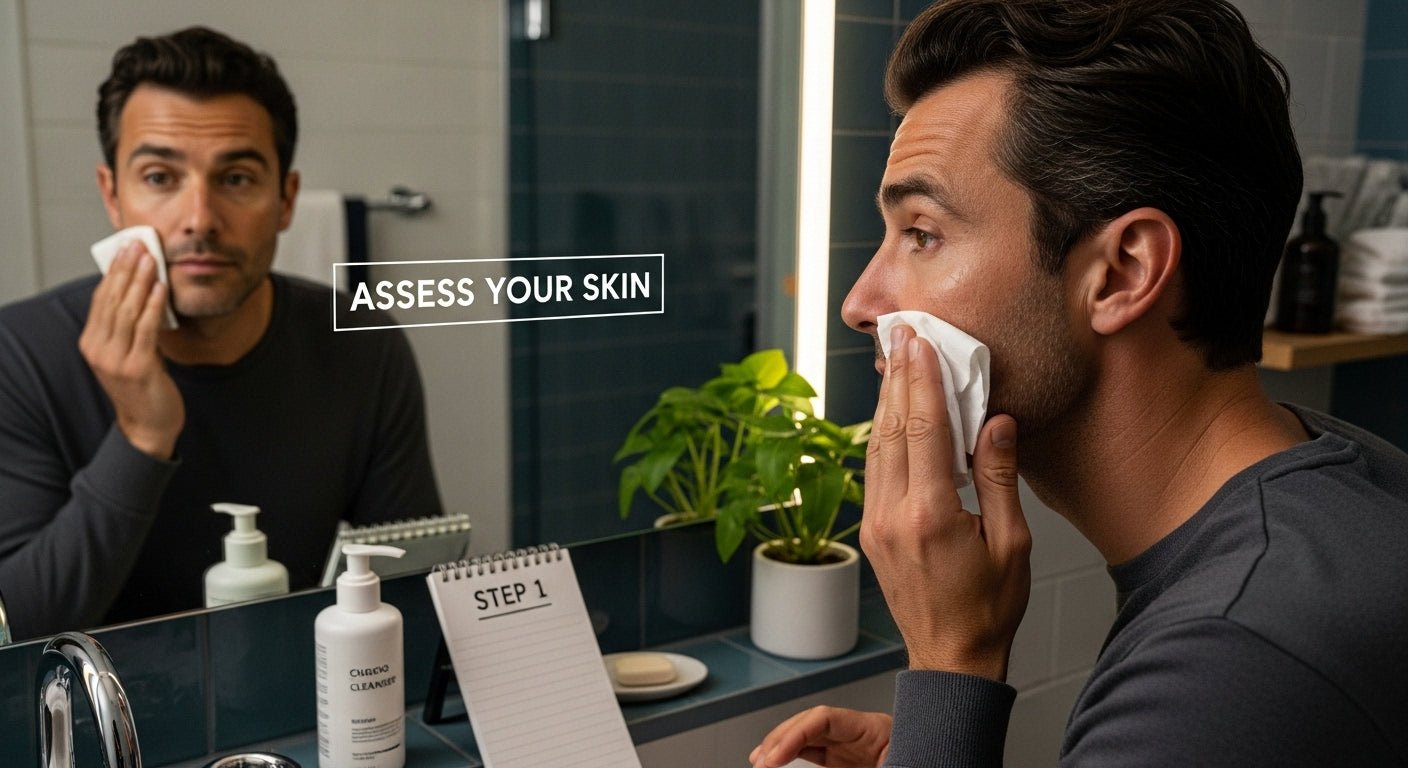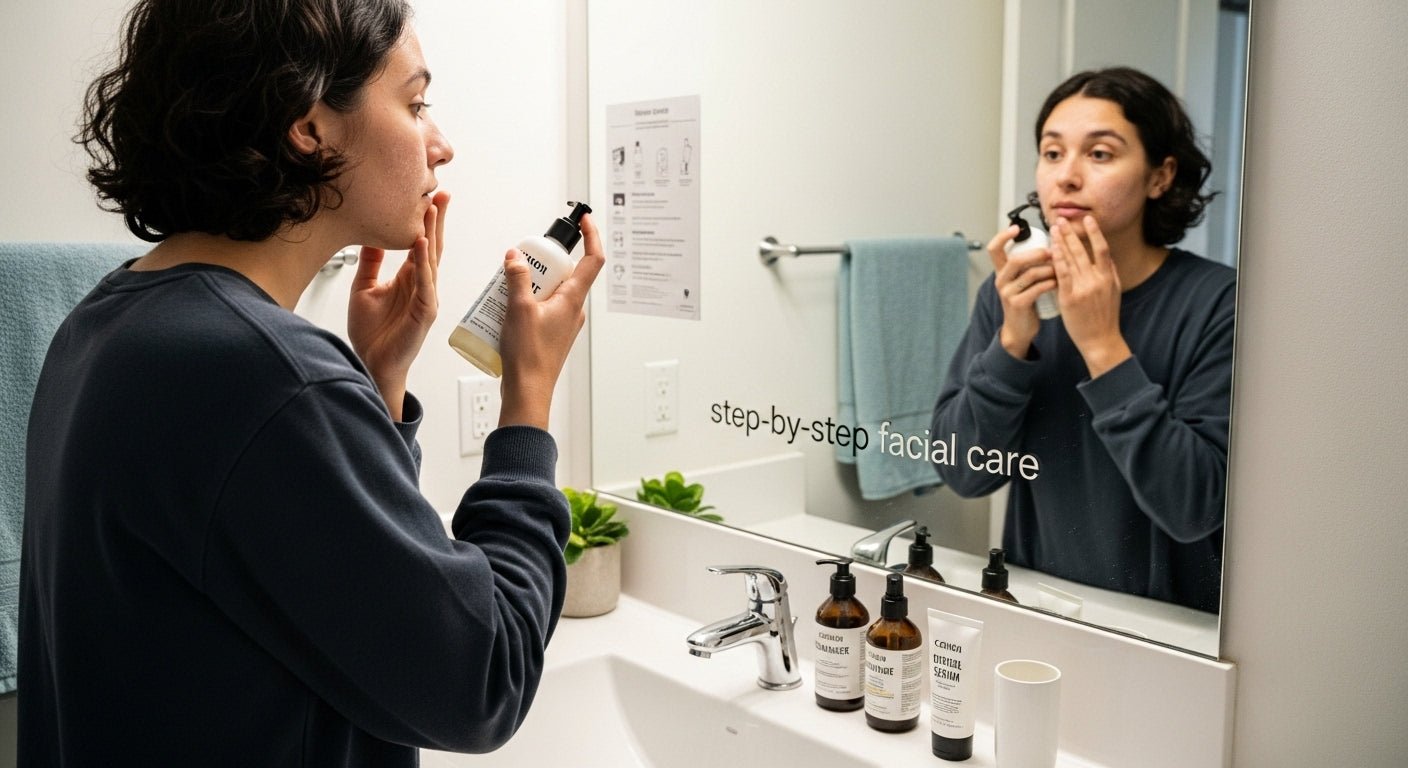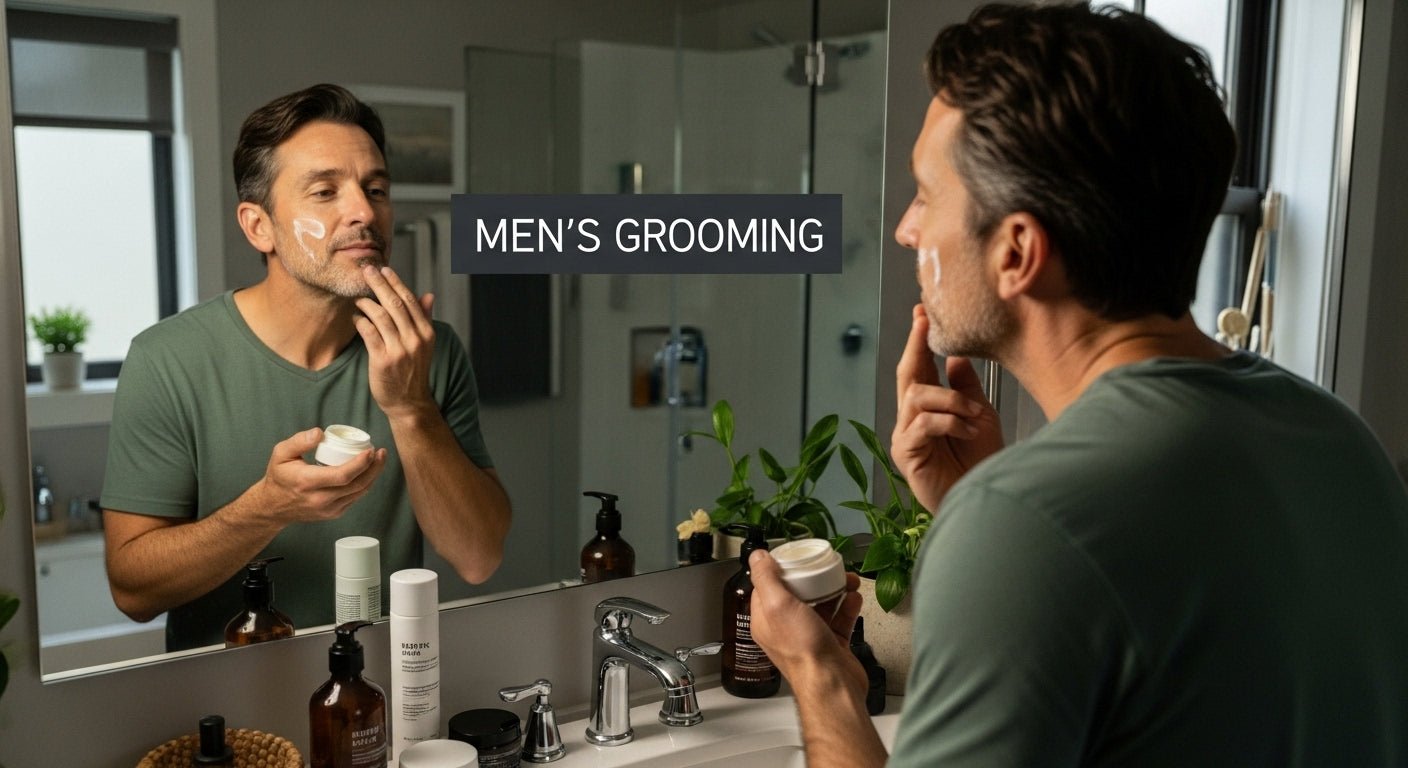Men often think skincare routines are complicated or only necessary for women. But did you know that over 60 percent of men admit they don’t even know their own skin type? That single fact upends the whole story. Because once you know your unique skin needs, keeping your face looking healthy and clear can actually be incredibly simple.
Table of Contents
- Step 1: Assess Your Skin Type And Needs
- Step 2: Cleanse Your Face Daily
- Step 3: Exfoliate Weekly For Clear Skin
- Step 4: Moisturize For Hydration
- Step 5: Apply Sunscreen Every Morning
Quick Summary
| Key Point | Explanation |
|---|---|
| 1. Know your skin type first | Identifying whether your skin is oily, dry, combination, or sensitive is crucial for selecting effective products. |
| 2. Cleanse your face twice daily | A consistent cleansing routine removes impurities and keeps your skin healthy and balanced, promoting overall clarity. |
| 3. Exfoliate gently once or twice a week | Regular exfoliation helps remove dead skin cells and improves texture, but it should be done without irritating the skin. |
| 4. Always moisturize after cleansing | Applying moisturizer locks in hydration and nourishes the skin, regardless of whether you have dry or oily skin. |
| 5. Use sunscreen every morning | Daily sun protection prevents premature aging and serious skin damage, making it essential for long-term skin health. |
Step 1: Assess Your Skin Type and Needs
Developing a simple skin care routine for men begins with understanding your unique skin characteristics. Knowing your skin type is the foundational step that determines which products will work best for your specific needs. Most men fall into one of several primary skin categories: oily, dry, combination, sensitive, or normal skin.
To accurately determine your skin type, start with a clean face and observe how your skin responds over several hours. Watch for key indicators: Does your face feel tight and flaky? You likely have dry skin. Do you notice excessive shine and occasional breakouts? That suggests an oily skin type. Areas of both dryness and oiliness typically indicate combination skin.
The skin assessment process requires careful observation and a bit of patience. After washing your face with a gentle cleanser, wait approximately two hours without applying any products. During this time, pay close attention to how your skin feels and looks. A white tissue test can provide additional insights. Gently press a clean tissue against different areas of your face. If the tissue shows oil residue, you likely have oily skin. If the tissue reveals minimal to no oil, you probably have dry or normal skin.
For men with sensitive skin, additional considerations are crucial. Look for signs of redness, irritation, or quick reactivity to new products. These symptoms suggest you need hypoallergenic and fragrance-free skincare options. Research from the American Academy of Dermatology highlights the importance of patch testing new products and introducing them gradually to minimize potential adverse reactions.
Beyond skin type, consider other specific skin concerns such as:
- Acne prone areas
- Uneven skin tone
- Fine lines and aging signs
- Sun damage
- Hyperpigmentation
By comprehensively understanding your skin’s unique characteristics, you’ll be equipped to select targeted products that address your individual needs. This personalized approach transforms a generic skincare routine into a strategic, effective grooming regimen tailored specifically for you.
Remember, skin assessment is not a one-time event. Your skin changes with age, lifestyle, and environmental factors, so periodically reassess and adjust your routine accordingly.
Step 2: Cleanse Your Face Daily
Cleansing is the cornerstone of any simple skin care routine for men, serving as a critical defense against daily environmental pollutants, excess oil, and accumulated grime. Your face encounters numerous challenges throughout the day - from city pollution to workplace stress - making a consistent cleansing routine more than just a cosmetic practice, but a fundamental health strategy.
The optimal cleansing process begins with selecting a gentle, pH-balanced facial cleanser matched to your specific skin type. Water temperature matters significantly - lukewarm water opens pores without causing unnecessary irritation, allowing your cleanser to work more effectively. Avoid extremely hot water, which can strip your skin of natural protective oils, leading to increased dryness and potential long-term damage.
Implement a methodical approach to facial cleansing. Start by thoroughly washing your hands to prevent transferring additional bacteria to your face. Use your fingertips, not washcloths or harsh scrubbing tools, to apply cleanser in circular, upward motions. This technique helps stimulate circulation while preventing unnecessary skin stretching. According to dermatological research from the Journal of Clinical and Aesthetic Dermatology, gentle circular motions promote better product absorption and minimize potential skin stress.
Pay special attention to typically neglected areas like around the nose, hairline, and jawline where oil and dirt tend to accumulate. Men with facial hair should take extra care, ensuring cleanser penetrates beneath beard or stubble to clean skin thoroughly. Rinse completely with lukewarm water, ensuring no residual product remains that could clog pores or cause irritation.
Your cleansing routine should occur twice daily - morning and evening - with slight variations based on your day’s activities. Morning cleansing removes overnight skin buildup, while evening cleansing eliminates daily environmental contaminants. For men with active lifestyles or those who exercise regularly, an additional quick rinse after workouts can help prevent breakouts and maintain skin clarity.
Key verification signs of an effective cleansing routine include:
- Skin feels clean but not tight or dry
- No visible residue or oily sheen
- Minimal visible pores
- Consistent, smooth skin texture
Remember that consistency trumps complexity. A straightforward, disciplined approach to facial cleansing will yield more significant results than sporadic, elaborate routines. Your skin will gradually adapt, becoming more balanced and resilient with regular, thoughtful care.

Step 3: Exfoliate Weekly for Clear Skin
Exfoliation represents a crucial step in a simple skin care routine for men, targeting the buildup of dead skin cells that can clog pores and dull your complexion. Think of exfoliation as a reset button for your skin, removing accumulated debris and preparing your face for more effective product absorption. Unlike daily cleansing, this process requires a more strategic and measured approach.
Frequency is key when it comes to exfoliation. Most men should aim for one to two gentle exfoliation sessions per week, depending on their skin type and sensitivity. Oily or acne-prone skin might tolerate slightly more frequent exfoliation, while sensitive skin requires a more delicate touch. The goal is to reveal fresher, smoother skin without causing unnecessary irritation or damage to your skin’s protective barrier.
Choose between physical and chemical exfoliants based on your skin’s specific needs. Physical exfoliants use small granules or textured surfaces to manually remove dead skin cells, while chemical exfoliants employ ingredients like glycolic or salicylic acid to dissolve cellular buildup. For men new to exfoliation, start with a gentle product that contains fine, uniform particles. Avoid harsh scrubs with large, irregular particles that can create micro-tears in the skin.
Research published in the National Center for Biotechnology Information highlights the importance of proper exfoliation technique. Apply your chosen exfoliant using light, circular motions, avoiding excessive pressure. Treat your skin like a delicate surface - aggressive scrubbing does more harm than good. Spend no more than 30 seconds to one minute massaging the product, focusing on areas prone to congestion like the forehead, nose, and chin.
After exfoliating, your skin will be more sensitive and receptive to moisture. Immediately follow with a hydrating moisturizer to replenish and protect your freshly revealed skin cells. This step helps prevent potential dryness and maintains the skin’s natural balance.
Verify the effectiveness of your exfoliation by checking for these signs:
- Skin feels smooth and refined
- Reduced appearance of blackheads
- Even skin tone
- No signs of redness or irritation
- Improved absorption of subsequent skincare products
Remember that everyone’s skin is unique. Pay attention to how your skin responds and be prepared to adjust your exfoliation frequency and technique. Some men might need less frequent exfoliation, while others might benefit from a slightly more aggressive approach. The key is observation, patience, and gentle care.
Below is a table comparing different exfoliation options for men, summarizing their features and recommendations based on information from the article.
| Exfoliation Type | Method | Suitable For | Features |
|---|---|---|---|
| Physical Exfoliant | Manual scrubbing with granules | Most skin types, beginners | Immediate effect, start with gentle products |
| Chemical Exfoliant | Ingredients like glycolic or salicylic acid | Oily/acne-prone, experienced users | Dissolves dead skin cells, no scrubbing required |
| Gentle Exfoliant | Fine, uniform particles | Sensitive/normal skin | Reduces risk of irritation |
| Harsh Scrub | Large, irregular particles | Not recommended | Can cause micro-tears, avoid use |
Step 4: Moisturize for Hydration
Moisturizing is the critical bridge between cleansing and protecting your skin, transforming a basic routine into a comprehensive skincare strategy. Unlike popular misconceptions, moisturizing isn’t just for those with dry skin - every skin type requires consistent hydration to maintain its health, resilience, and natural protective barrier.
Timing is everything when applying moisturizer. The ideal moment is immediately after cleansing or exfoliating, when your skin is still slightly damp. This approach helps lock in moisture and allows the product to penetrate more effectively. Think of your skin like a sponge - it absorbs moisture most efficiently when slightly wet, creating a more substantial hydration effect than applying to completely dry skin.
Choosing the right moisturizer depends entirely on your specific skin type and concerns. Men with oily skin should opt for lightweight, non-comedogenic formulas that provide hydration without additional shine. Those with dry skin benefit from richer, more intensive creams containing ingredients like hyaluronic acid and ceramides. If you have combination skin, consider using different moisturizers for different areas or a balanced formula that addresses multiple needs simultaneously.
Research from dermatological studies emphasizes the importance of consistent moisturizer application. Beyond simple hydration, quality moisturizers serve multiple functions: they protect against environmental damage, help regulate oil production, and can even minimize the appearance of fine lines and uneven skin texture.
Application technique matters as much as product selection. Use gentle, upward motions when applying moisturizer, which helps stimulate circulation and prevents unnecessary skin stretching. Start with a small amount - about a dime-sized portion - and gradually increase if needed. Focus on areas prone to dryness or early signs of aging, such as around the eyes, forehead, and neck.
Consider these critical signs of proper moisturization:
- Skin feels soft and smooth, not tight or greasy
- No visible dry patches or flakiness
- Consistent, even skin texture
- Reduced appearance of fine lines
- Skin looks naturally hydrated
For men with active lifestyles or those exposed to harsh environmental conditions, consider a moisturizer with added SPF protection. This dual-purpose approach simplifies your routine while providing essential defense against UV radiation. Remember that moisturizing is not a one-size-fits-all solution - your skin’s needs will change with seasons, age, and lifestyle factors. Stay observant and be willing to adjust your approach as needed.

Step 5: Apply Sunscreen Every Morning
Sunscreen represents the most powerful yet often overlooked component of a simple skin care routine for men. Far beyond a cosmetic choice, daily sun protection is a critical defense against premature aging, skin damage, and potential health risks associated with prolonged UV exposure. Think of sunscreen as your daily armor against environmental aggression, protecting your skin’s long-term health and appearance.
Choosing the right sunscreen requires understanding your specific skin needs and lifestyle. Look for broad-spectrum protection with at least SPF 30, which blocks both UVA and UVB rays. For men with active lifestyles or those spending significant time outdoors, consider water-resistant formulas that maintain protection during exercise or extended sun exposure. Individuals with sensitive skin should opt for mineral-based sunscreens containing zinc oxide or titanium dioxide, which provide gentler protection compared to chemical alternatives.
Application technique is just as crucial as product selection. Apply sunscreen as the final step in your morning skincare routine, after moisturizer but before any makeup or foundation. Use approximately one teaspoon of product to cover your entire face and neck, ensuring complete and even coverage. Many men make the mistake of applying too little sunscreen, dramatically reducing its protective capabilities. Pay special attention to often-neglected areas like the ears, hairline, and around the eyes.
Dermatological research highlights the importance of reapplication throughout the day. For men working indoors or with minimal sun exposure, a morning application typically suffices. However, if you’re spending time outdoors, reapply every two hours or immediately after swimming or excessive sweating. Consider keeping a travel-sized sunscreen in your bag or car for convenient touch-ups.
Beyond traditional facial sunscreens, modern formulations offer advanced benefits. Look for products that combine sun protection with additional skincare advantages, such as:
- Lightweight, non-greasy textures
- Moisturizing ingredients
- Subtle mattifying effects
- Anti-aging compounds
- Minimal white cast on skin
Verify the effectiveness of your sunscreen application by checking for these indicators:
- Even, smooth application with no visible streaks
- No white residue on skin
- Comfortable, non-sticky feeling
- Skin appears protected but not overly shiny
Remember that consistent sun protection is a year-round commitment. UV rays penetrate clouds and windows, making daily sunscreen application crucial regardless of weather conditions. Your future self will thank you for developing this essential habit, preserving your skin’s health and youthful appearance.
This table provides a checklist to help you verify if each step in your men’s skincare routine is completed effectively, using the clear signals mentioned in the article.
| Step | How to Verify | Signs of Success |
|---|---|---|
| Cleansing | After washing | Skin feels clean, not tight or dry |
| Exfoliating | 1-2 times per week | Smooth, refined texture, no irritation |
| Moisturizing | After cleansing/exfoliating | Skin feels soft, no dry patches |
| Sunscreen | Every morning | Even application, no white residue |
Make Every Step of Your Skin Care Routine Count With GNS Beauty
Struggling to find the right products that match your unique skin type and deliver real results? Achieving a simple skin care routine for men is only possible when you use carefully chosen essentials that cleanse, exfoliate, moisturize, and protect without the guesswork. Many men face irritation, dryness, or leftover shine simply because they do not have the right tools for each step. That is where GNS Beauty & Personal Care bridges the gap between advice and action.

Ready for visible change? Explore handpicked, high-quality face cleansers and hydrating moisturizers that work with your skin, not against it. You will find solutions for each stage of your routine, including gentle exfoliators and daily sunscreens for powerful protection. With our eco-conscious and luxury selection available at GNS Beauty & Personal Care, you will feel confident taking control of your skin health today. Visit GNS Beauty & Personal Care now to experience a smarter way to shop for men’s grooming and wellness. Your skin deserves the right start, so do not wait. Shop now and build your best skin care routine.
Frequently Asked Questions
How do I determine my skin type?
To determine your skin type, start with a clean face and observe how your skin feels after a few hours without products. Look for signs of dryness, excess oil, or a combination of both. A white tissue test can help; if the tissue shows oil, you likely have oily skin, while minimal residue may indicate dry or normal skin.
How often should I exfoliate my skin?
Most men should aim to exfoliate once or twice a week, depending on their skin type. Oily skin can handle slightly more frequent exfoliation, while sensitive skin needs a gentler approach. Pay attention to how your skin reacts and adjust accordingly.
Why is moisturizing important for all skin types?
Moisturizing is crucial for every skin type because it maintains hydration, protects the skin barrier, and enhances skin resilience. Applying moisturizer immediately after cleansing or exfoliating helps lock in moisture and promotes healthier skin.
How can I effectively apply sunscreen?
Apply sunscreen as the final step in your morning skincare routine, after moisturizer. Use about one teaspoon to cover your entire face and neck, and ensure even coverage, including often-neglected areas like the ears and hairline. Reapply every two hours if you are outdoors, especially after swimming or sweating.








Leave a comment
All comments are moderated before being published.
This site is protected by hCaptcha and the hCaptcha Privacy Policy and Terms of Service apply.